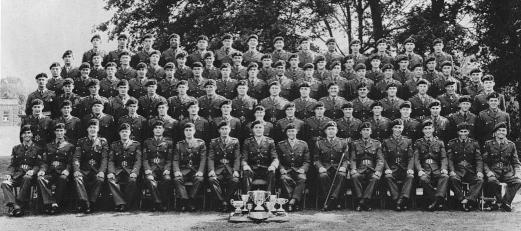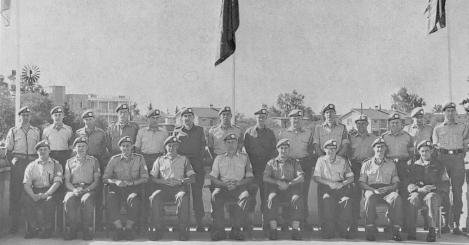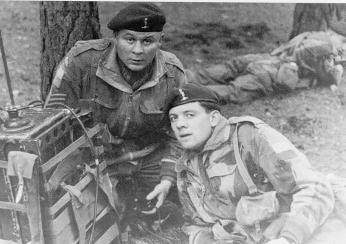
Plate 30. 216 Signal Squadron (Parachute Brigade Group) July 1963.
Click to enlarge the picture.(204k)
Aldershot 1958-1960
Life in Barossa Barracks settled down again quickly to the routine of peacetime in Aldershot. It was decided in 1959 that Royal Signals units were henceforth to be designated by a number identifying the unit (in an historical context) regardless of any change in role or grouping. Independent squadrons were to be identified by a three figure number; the first figure to be a '2'. On 1 September 1959, 16th Independent Parachute Brigade Group Signal Squadron changed its title to 216 Signal Squadron (Parachute Brigade Group). The '2' denoting its independent status and the '16' being the 1st and 6th Airborne Divisional Signals connotation.
In spite of this change in title, the role of the unit remained the same. The Squadron continued to provide communications support to 16th Independent Parachute Brigade Group. The organisation had not significantly changed from that illustrated in Figure 4 at Appendix 2. Radio equipment consisted in the main of WS No 19 and WS No 62 and the first of the Larkspur C11 sets.
It had also been decided that the existing barracks in Aldershot no longer met the requirements of the Regular Army and a barrack rebuilding programme for Aldershot was planned. 216 Signal Squadron moved from Barossa Barracks, Stanhope Lines to Elles Barracks in Farnborough on 5 January 1960. This move was to allow Stanhope Lines to be demolished prior to reconstruction. Also in July 1960, 16th Independent Parachute Brigade Group dropped the word 'Independent' from its title. This change, however, did not affect the Signal Squadron in any way.
Kuwait 1961 [Operation VANTAGE]
In June 1961, General Kassem who had come to power in Iraq following the overthrow of the Hashemite regime in 1958, declared that Kuwait was an inseparable part of Iraq. This declaration, coming as it did some six days after a new agreement had been signed between Britain and Kuwait, brought to a crisis many years of territorial dispute. Britain reacted to this crisis and amongst other troops, the 2nd Battalion The Parachute Regiment was deployed to Kuwait. A Signals rear link detachment went with the Battalion. Confrontation was avoided between Iraq and Kuwait and the Battalion, with the Squadron detachment, withdrew to Bahrain in July. The Detachment soon went to work again in Bahrain and established a link from Bahrain airfield to a camp being constructed by Sappers in the desert some 20 miles away.

Plate 31. Staff and Signal Officers, UN Cyprus 26 March 1964.
Click to enlarge the picture.(129k)
Aldershot 1961-1964
Major W T MacFarlane took over command of the Squadron from Major Peat on 26 June 1961. Life in Farnborough continued very much as it had done earlier in Aldershot. Training was hectic and exercises, sport, recruiting, visits and demonstrations all added up to a very busy unit. Parachute training also continued at a hectic pace. 215 parachute descents, for example, were made from helicopters, twin pioneers, Hastings and balloons in one week in early June.
Major A H Dennis, who had previously served with the Squadron from 1949 to 1952, took over command of the unit on 19 July 1963. Major Dennis was in fact the first officer to become OC who had previously served with the Squadron. However, the routine of soldiering in England was yet again to be disrupted at the end of the year, this time by the escalation of hostilities between the Greek and Turkish communities in Cyprus. The Squadron was recalled by telegram from Christmas Leave.
Cyprus - UNFICYP 1964
Although Cyprus achieved independence in August 1960, certain weaknesses in the Constitution resulted in tension and mistrust between the Greek and Turkish communities on the island. In December 1963, that tension erupted into violence. Fighting became widespread in Nicosia between Turks and Greeks.
The United Kingdom, Greece and Turkey were bound by Treaty to guarantee the independence of Cyprus. On 26 December 1963 British troops from the Sovereign Bases {Dhekelia and Episkopi) moved into the Republic and with the Greek and Turkish national contingents attempted to keep the peace under the title of 'The Joint Truce Force'. The Turkish and Greek national contingents, however, abandoned their neutral status and joined their ethnic comrades on the island.
16th Parachute Brigade Group, as part of the British contingent, was deployed from UK to Cyprus (Operation HOGMANAY). The Signal Squadron started to fly from Lyneham in Britannia aircraft on the night of 2 January 1964. The advance party of eight men including Major Dennis arrived at Akrotiri at about 1000 hours on 3 January. The main body of the Squadron arrived at Nicosia at about 1500 hours on 4 January. Brigade HQ was established at Nicosia Club and the Signal Squadron and administrative elements of the HQ established themselves at Elizabeth Camp also in Nicosia.
By the close of 4 January, local telephones had been installed in the Nicosia Club, the Brigade Command Net had been established and the exchange at Elizabeth Camp had been taken over by the Squadron. Over the next few days the communications were improved. As freight arrived, radio nets were extended, the line network was increased and SDS was introduced.
Squadron deployment consisted of the Squadron Commander and forty men at Nicosia Club providing communications for Brigade HQ. At Elizabeth Camp the Squadron Office, Stores, MT, Pay and Technicians were established. Nicosia Club was responsible for the control of the Brigade Command Net and for all stations in Nicosia Town and to the North. Elizabeth Camp was responsible for all stations on the Brigade Administrative Net, detachments at RAF Nicosia and those to the West of the town. A 40 line F & F exchange also was established to serve the Elizabeth- Ubique Camp complex.
Soon fighting between the two communities had spread throughout the island. On 9 January, Brigade HQ notified all troops comprising the Joint Truce Force that from the time of deplaning they were deemed to be on active service. The fighting, however, had stopped by 19 January and active service was ended on 31 January 1964.
A Squadron detachment was still in Bahrain with 2nd Battalion The Parachute Regiment during this deployment to Cyprus and the Rear Party back in Farnborough even won the Aldershot District Minor Units Cross Country Championships.

Plate 32. WS No 62 Detatchment on Exercise 1965.
Click to enlarge the picture.
On 5 February the leading elements of the UK based 3rd Division including members of 3 Division HQ and Signal Regiment arrived in the island to set up a Joint Force HQ in No 2 Site, RAF Nicosia. General Carver assumed command at 1800 hours on 19 February and JFHQ opened at RAF Nicosia at 0200 hours on 20 February.
On 4 March 1964, the UN Security Council accepted a resolution to introduce a UN peace keeping force into Cyprus. It was also agreed by the Government of Cyprus that a British contingent should be part of the UN force. Various national contingents who were to make up the UN Force started to arrive in Cyprus towards the end of March. Those British troops already in Cyprus were designated as the British contingent. The units of 16th Parachute Brigade Group were issued with UN clothing and vehicle signs and on 26 March the red beret was replaced by a UN light blue beret although a maroon patch was worn behind the UN cap badge. HQ 16th Parachute Brigade Group was re-designated HQ Nicosia Zone.
On 29 April, the Squadron handed over its tasks to a Canadian HQ and Signal Squadron and moved to transit accommodation in Famagusta the next day. Between 3- 7 May the Squadron flew back to UK and leave.